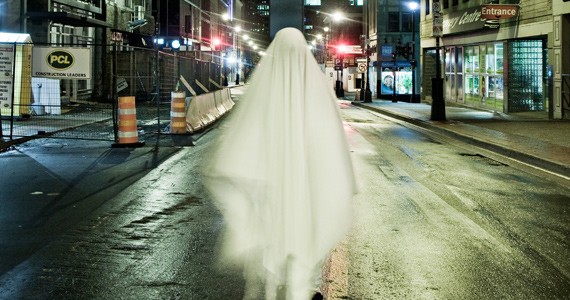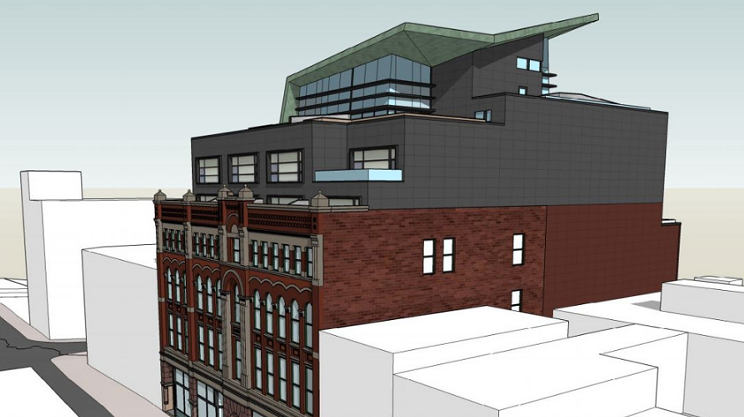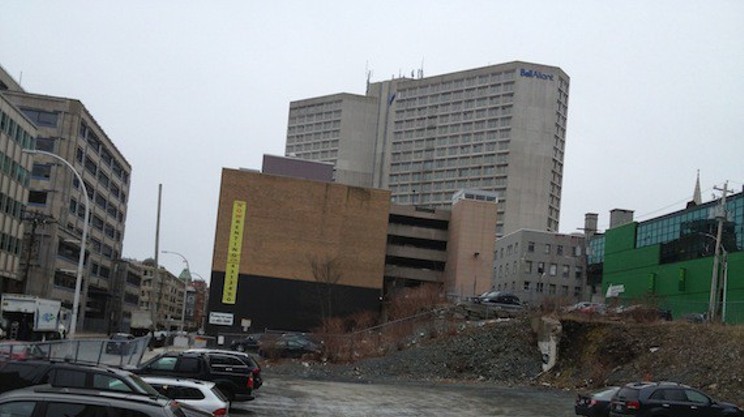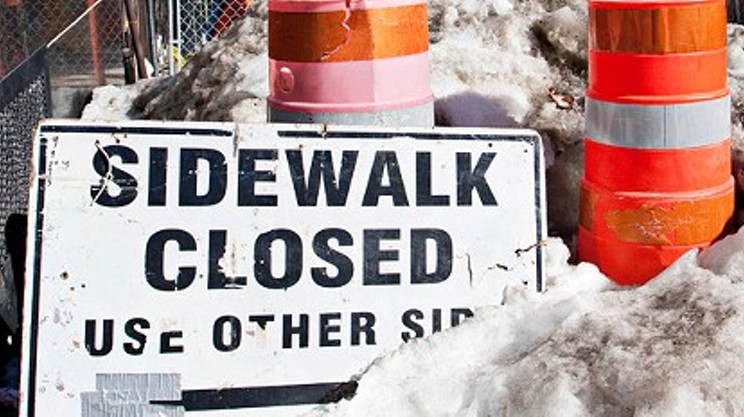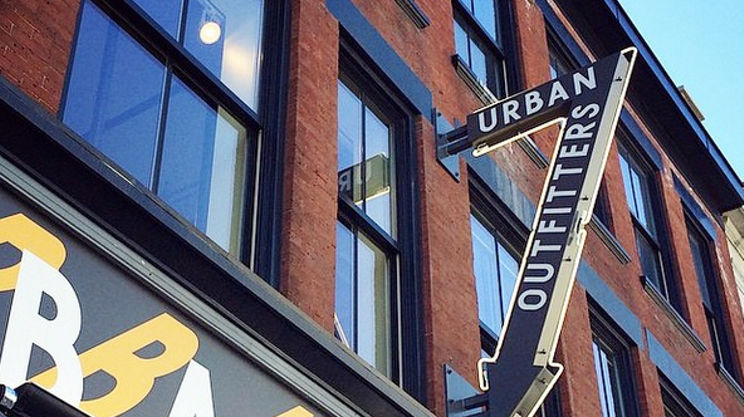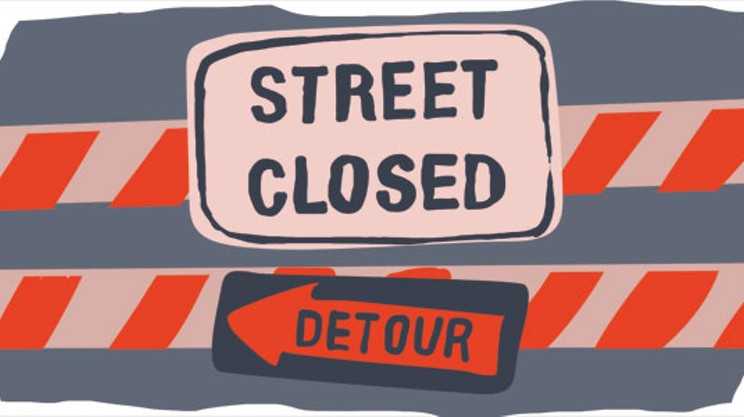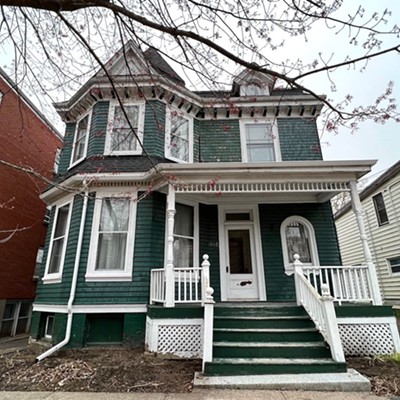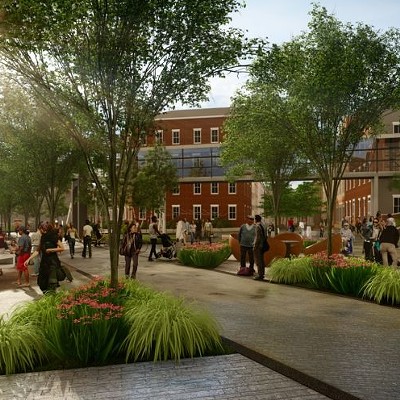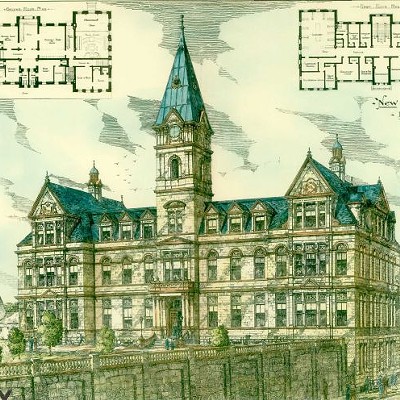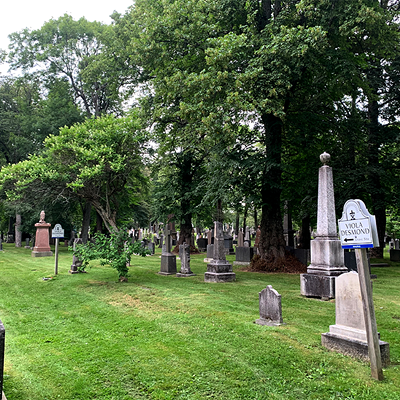Silhouettes flicker on the pale white of St. Paul's Church, shadows lit by the floodlights of Grand Parade. On a foggy Friday night, they've paid $10 each to gather for a dramatic tour of Halifax's spookiest haunts. Yarns are spun of shipwrecked sailors and vengeful spirits. Here, overlooking Barrington Street, the tour guide turns to the Halifax Explosion. Thousands were injured in the blast, the area underfoot covered in blood and wreckage.
"Where do ghosts come from?" he asks. "Most of us cannot see ghosts. Most of us do not have the second sight. But every now and then, something is left behind that can't quite be explained following a great, devastating loss of life. A sort of supernatural echo, or ghostly remnant of a great tragedy that stands as a memorial for all to see."
That's Barrington Street, really. A supernatural echo; a memorial to a once-great corridor extinguished by decades of poor planning. The ghost of a street. The tour group walks down Prince, past the empty coffin of the former John W. Doull bookstore. Which feels all the more empty, as a couple of doors down, Stillwell has been packed for hours.
Flip a coin, pick an address on Barrington Street at random, and it's just as likely to be cold and empty as it is crackling with energy. The city's second-busiest street, its main traffic corridor, has been left to rot for generations. But today, the grave is being dug up. Construction is happening on damn near every block. Businesses new and old are bringing a spirit back to the street, as developments in the downtown rise on an unprecedented scale. Barrington Street is crawling, clawing its way back to life.
The story of Barrington has been told a lot. Every couple of years some media outlet (often The Coast) writes fattened prose attempting to check the downtown's temperature. The divination is usually the same: How's Barrington doing? Not the best. Is it going to get better? Maybe soon! Developers will say the city needs better development. Small business owners say it's hard owning a small business. Throw in some black-and-white photos of a busy 1950s boulevard and call it a night. This isn't a new problem.
Let's get the history out of the way, then. Barrington Street was, once, the destination for downtown Halifax. Gallantly dressed couples might take in a show at the Capitol Theatre (now demolished) before riding an electric trolley (now replaced) to a swanky restaurant (likely out of business). But monoliths like Scotia Square and the Cogswell Interchange erupted, blocking off traffic. Malls came into being. The suburban base of HRM began shopping at the new big-box retailers opening up in far-away business parks. The lifeblood drained away.
"We were enamoured with sprawl," says Paul MacKinnon. "I think they were just thinking, as long as people are building somewhere in Halifax, that's good. I think the city just took their eye off the ball of downtown."
MacKinnon's been executive director of the Downtown Halifax Business Commission for the last 12 years. On day one he was already hard at work trying to help put together the city's Historic District plan. He's seen Barrington sit stagnant, stuck in a municipal limbo.
That's begun to change, these last few years. The Barrington Street Historic District plan provided tax credits and grants to property owners looking to renovate within heritage guidelines. Tied into that was HRM By Design, the municipal planning strategy approved by city council in 2009. Suddenly, Halifax had strict rules for the heights and facades that could and could not be in a heritage district like Barrington Street. It all came online just in time for the global economy to hit the shitter. Financing dried up, and the slow process to revitalize Barrington got slower.
It's only been in the last three or four years that movement has returned—and it's come back hard. In the last two years there have been 35 developments under construction and approved in the downtown core. The blood is pumping again, which has created a set of new problems.
"We basically went 30 years without any downtown development," MacKinnon says. "No one's around that has any experience with doing it. Both the developers and the city, and ourselves and storeowners. We're in the process of figuring that out on a bunch of spots all at once."
Over 10 of those spots belong to Starfish Properties. The development company, headed by Louis Reznick, has snatched up some of the area's prime real estate. They're renting out the old Carsand-Mosher spot, busy constructing the former CDPlus location and are close to a tenant on the renovated site that once housed Sam the Record Man. Across the street, construction has begun on the 22-storey condo development built from the grounds of the demolished Roy Building. It's one of two properties on the street grandfathered in from before HRM By Design, allowing it a larger height. Walking down Barrington means seeing a lot of Starfish logos in a lot of empty storefronts.
"We tend to get blamed unfairly," says Rob Landry, manager for Starfish. "We're buying properties of businesses who closed. We didn't close the business."
The sad truth is that many of the longtime tenants that anchored Barrington were on the wrong side of history. Sam the Record Man, Carsand-Mosher, CDPlus, Doull's books (which moved to Dartmouth)—all faced problems beyond a forgotten street. It's not the best time to be in the CD or printed book business. Landry says Starfish has rented as many spaces as they can, but admits businesses can be wary. The Roy's storefront, once home to a downtown Dooly's, sat empty for years precisely because of the lofty plans Starfish has for the spot. Business owners don't often want to sign a lease without knowing how long they'll have the spot before redevelopment.
Still, everything has a cycle, Landry says. Starfish is putting a lot of money into the ground, banking on what Barrington will become again.
"It takes awhile for the flower to emerge from the ground," he adds. "It took us longer to die back than other cities, so it's taking us longer to come back to life."
"I think it was very hard for a lot of developers to adapt to the fact that when the Downtown Plan came in, that this is all you can do," says Waye Mason. "You can do this height and this mass and it has to look like this on the street."
Mason, councillor for Halifax Peninsula South, believes Barrington's strict guidelines stand in contrast to the "wild west" of development happening on other major corridors. That's where the standard operating procedure tends to approve any Municipal Planning Strategy changes a developer wants. Those who buy a residential property can build a commercial tower, earning a healthy profit in the process. "Good for them," Mason says, "and council is, frankly, dumb enough to keep approving it. It's just horrifying."
In some circles, Mason is branded as anti-development. He's tarred and feathered with the label NIMBY (Not In My BackYard) for being wary of enormous construction projects. Indeed, the afternoon he meets to talk about Barrington is the day after a contentious public meeting about new apartment buildings in the south end. Hundreds of signatures and community voices didn't stop two new towers from wedging themselves onto Wellington Street. He's pissed. But the annoyance fades as he strolls along Barrington, giddy about what's being accomplished. Jaywalking isn't illegal in Nova Scotia, he mentions while criss-crossing the street and poking his head into the under-renovation NFB building. He squints against the glass to check out the progress inside the old Sam's, and points out the steel supports which will help secure the new Roy.
"We have never had this kind of development in the downtown, like all at once."
For owners, renters and the public, it's sure felt like a long time. But in city terms, two-and-a-half years to get 35 projects up and running is lightning fast. Still, there are property owners who decry the heritage guidelines and the demands they place on renovations. Mason doesn't buy it. He points to the "little, tight" project that Steve Caryi is putting into the fire-gutted National Film Board site— 16 apartments and some retail. "It's not going to be a huge money-maker, but it's going to work for him."
Compare and contrast with the Green Lantern building across the way, whose owner Jeff Webber has held out against a municipal development process he's called impossible.
"He should put up or shut up," Mason says of Webber. "Renovate or sell to somebody. He shouldn't hold the building hostage for an unreasonably high price to make his point."
So, yes, there's a lot happening. But it's all future-tense. For those already trying to live on Barrington, a shiny new street four years from now doesn't make up for standing in the middle of a construction war zone. It's "noisy and grim" right now, Mason says. Construction all over downtown has shuttered streets, blocked off sidewalks and reduced foot traffic. It's only going to get worse, as more projects (including the former home to Night Magic on Sackville Street, Tramway renovations and the redevelopment of the Discovery Centre site) begin to take shape in the coming months.
"It's about business struggling to survive under very difficult circumstances, hoping to come out the other side for when these renovations are done," Mason says. Hard for those on the street, and discouraging to anyone new who'd rather wait to rent until the steel fences are put away and the dust has settled. "Who wants to be next to that? Who wants to open up a new store and try and establish that?"
Just try and hold on, says Paul MacKinnon. Things will be better. For some businesses, Barrington is already booming. For others, it's the worst they've ever seen.
"You go by Stillwell at 4:50 on a Tuesday and it's packed," MacKinnon says. "2 Doors Down is one of the hottest restaurants in downtown. They're both on Barrington Street, but yet you could have businesses a door or two doors down from them that are having a really hard time."
If anything, he's worried the street is too busy. Every day, thousands of buses roar down a cramped Barrington that's already packed with cars and heavy trucks.
"It's disruptive," he says. "If you want to have a nice pedestrian-friendly atmosphere, all those buses don't help that."
But the trams clanged up and down Barrington in the '50s, too. The street is old, and the challenges it faces are often the same ones Barrington has always fought; preserve the heritage, bring in more shoppers and land some big retail tenants. When MacKinnon first started, he asked businesses in the downtown what would be their be-all, end-all fix to the street's problems.
"Everyone would say, 'We need a Starbucks. If we could only get a Starbucks on Barrington Street, that would solve everything.' Well, we do have a Starbucks now, and it didn't solve everything."
More residential, that's what MacKinnon says the neighbourhood needs. Putting more people onto the street to shop is the key to a healthy future. "Bringing customers right to their front door, there's no question it's going to be beneficial."
Mason sees the reverse. Exciting businesses are the draw for feet on the ground. He'd like to see landlords become more aggressive in dividing up rental spaces to allow more unique businesses to open.
"Get more Nooks, more Freak Lunchboxes," he says. "Those businesses survive."
Not everyone agrees. Mike Turner, for instance, remains skeptical. People can live downtown or play downtown, but where they're working is what will really impact Barrington. President of Turner Drake & Partners, Turner is worried the glut of downtown office space will strangle Halifax's economic future. Rents are already declining, he says, dissuading renovations. We may already be too late.
"We lost a huge opportunity," Turner says about how long the city ignored its core. "It could have been a great downtown. It could have been the kind of downtown people would kill for, and we've just let it go. It's criminal."
What the future holds still remains murky. The concrete tomb of Scotia Square is still in the way, though renovation plans call for a remade glass exterior to brighten up the place. The city's also 12 months out from the technical study on how to finally tear down the Cogswell Interchange. When that project's complete, Barrington will have reclaimed 600 metres of sidewalk for additional retail space.
"Again, that's five years away," Mason says. "That doesn't help the person trying to pay rent in February."
Barrington Street, Mason admits, has struggled his whole life to regain its footing. Businesses have come and gone a dozen times over. The dream of Barrington, the ideal pictured in those black-and-white photos, gets further and further away every year. The majority of people in Halifax have only known Barrington since after its fall. So why still chase some phantom that doesn't exist?
"At a certain point, we maybe just have to embrace that Barrington is going to be a bit of a mess," MacKinnon says. Make it the "funkier street," he argues. The experimental sibling to Spring Garden Road that takes bigger risks on its storefronts. Will that stop it from ever dying again?
"I don't know," MacKinnon admits. "I guess we can take some comfort in the fact that the situation it's in now, where it's not working as well as it should but it's still kind of working, it's been like that really since the '50s."
Short of another Explosion, there's no reason to believe Barrington will decline even further, is his point. Halifax has solidified the street as historic. No one's arguing over preserving heritage anymore, and that alone is a substantial step. In this city, there's no one who doesn't want an active, living downtown.
"I certainly would never want to say it couldn't come back to its heyday," MacKinnon says. "I think the bones of a great street are all still there."
The historic stretch of Barrington runs north to south between Cogswell and Spring Garden Road. But more symbolically, it spans the length between the Interchange and the Old Burying Grounds. On one side, the tentacled concrete horror of municipal fuck-ups. On the other, the graves of history. Two sites, both filled with stone monuments to the past. It's a ghost of a street, Barrington. A spirit refusing to move on into eternal slumber. Barrington still fights to stay alive.
Jacob Boon is The Coast's city editor.

